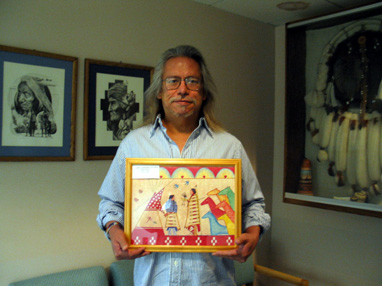 |
Donel E. Keeler shares his artwork with the Ear, Nose and Throat clinic at UNMC. |
Behind him are six vibrant ponies — his gift to the family of the young maiden he wishes to marry.
The colorful scene of a long-ago Lakota courtship is the newest piece of artwork now on display in the Ear, Nose and Throat clinic at UNMC.
The colored pencil drawing delves into the history of the Sioux people, said Donel E. Keeler, the freelance artist who donated the piece to the clinic — located on the second floor of the Durham Outpatient Center.
“The Sioux were a nomadic people, following the buffalo,” Keeler said. “So horses, which were very important to the tribes, were usually given as a way to honor the bride and as a dowry to the woman’s family.”
For Keeler, who is part Dakota Sioux and part Northern Ponca, it is important to share the history of the northern plains tribes with others — any way he can.
When Keeler found out about the ENT exhibit from a friend who brought her daughter to the clinic, he decided to check it out.
“I stopped by the clinic about a month ago on my way to a doctor’s appointment and asked the nurse if I could see it,” Keeler said. “When I saw it I thought to myself, ‘if I have the chance to donate something I will.’ ”
Last week, Keeler had his chance.
When he arrived at the clinic for a hearing screening he brought a print of his prize-winning drawing, “Lakota Courtship — Love Ponys,” with him.
It was a pleasant surprise for Barbara Heywood, M.D., assistant professor in UNMC’s Department of Otolaryngology.
“It’s a generous donation,” Dr. Heywood said.
The drawing will join the eclectic mix of American Indian arts and crafts already on display. The exhibit, which was established 30 years ago by Anthony Yonkers, M.D., professor in UNMC’s Department of Otolaryngology, was expanded three years ago. It includes a mixture of beadwork, pottery and other handcrafted items.
Many of the items were donated by Dr. Yonkers, or acquired by Dr. Heywood during her residency training on the Pine Ridge Indian Reservation in South Dakota in the mid-1970s.
“When I arrived for my residency rotation, I was presented with a fully beaded head mirror to use for the ENT exams,” Dr. Heywood said.
The brightly beaded head mirror is included in the exhibit. Other items on display include a Navajo sand painting, a woven basket from the Nootka Tribe of British Columbia and a leather medicine bag decorated with porcupine quills from Pine Ridge.